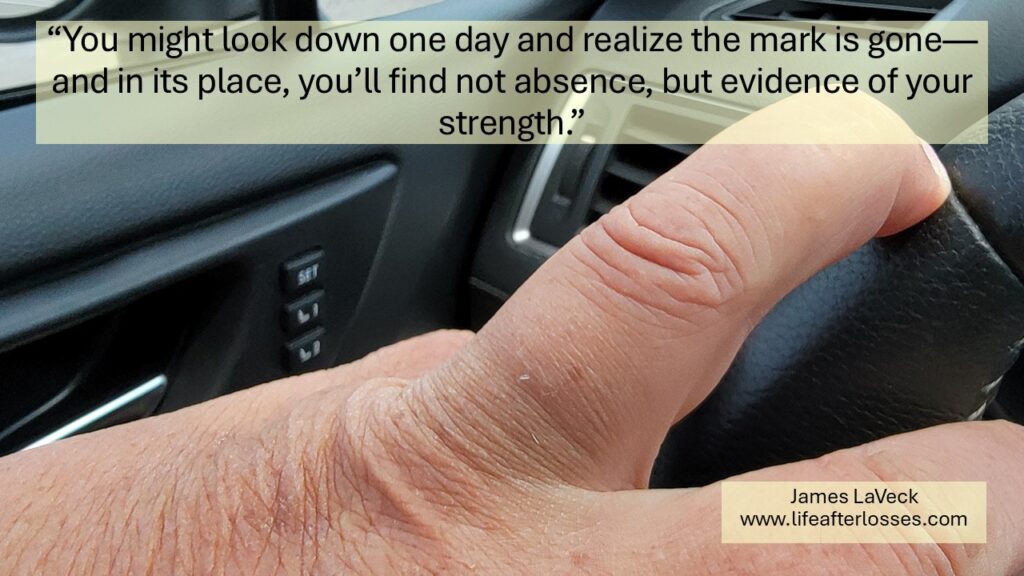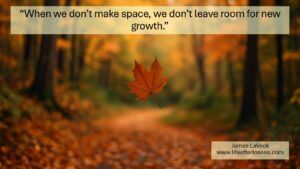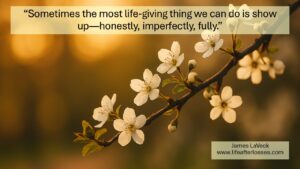The other day, a photo memory popped up on my phone — one I’d taken years ago of my left hand. I’d shared it in a post about the faint indentation my wedding ring had left behind after Bob died. Out of curiosity, I looked at my hand again, expecting to see that same shadow.
It was gone.
No mark. No discoloration. Nothing to trace with my thumb.
And for a moment, I didn’t know how to feel about that.
The Phantom Ring
After fifteen years of wearing that ring, I remember how foreign my hand felt the day I took it off. The sensation was like a phantom limb; my brain insisted the ring was still there, and I’d catch myself reaching to spin it, only to feel bare skin. For a long time, that absence hurt more than I expected.
I used to joke that the ring didn’t expand as I did, but it’s truer to say that love leaves an impression. For years, I could still see it: a faint groove, a difference in color, the physical proof that something once rested there. Eight years later, I could still make it out in photographs.
That small, silent mark became a metaphor for everything grief leaves behind. Even after the pain dulls and life moves forward, the imprint remains.
The Marks We Keep
When I wrote about this a few years ago, I talked about how our bodies and hearts hold on to memory — not in a haunted way, but in a human one. The science says not every cell in our body renews every seven years like we once believed. Some do, some don’t. Some parts of us quite literally remain the same.
That’s grief. That’s love. That’s memory.
We don’t shed the people we’ve loved just because time passes. We carry them in our mannerisms, our jokes, our quiet rituals. In the recipes we still make. In the songs we can’t quite skip.
Those impressions, visible or not, become part of the landscape of who we are.
Healing Isn’t Erasing
This time, seeing the mark gone didn’t feel like loss. It felt like recognition.
The indentation faded not because the love disappeared, but because I’ve continued living. I’ve used my hands for lots of things: to write, to cook, to hold others, to build new chapters. Over time, skin renews. Muscles change. We adapt.
That’s what healing looks like: not a pristine surface, but a body that’s lived.
I used to feel the mark would always be there, especially after it was there for so long. I felt losing it would somehow mean losing another piece of him. Now, I see it differently. The ring’s absence no longer feels like emptiness; it feels like strength.
The love remains, even if the mark doesn’t.
Re-defining Our Impressions
We all have our versions of that ring indentation. Scars that never fully blend. Wrinkles that carry laughter or worry. Emotional grooves left by people who’ve shaped us, for better or worse.
And maybe the point isn’t to make them vanish. Maybe it’s to learn to reinterpret them. Maybe we need to see each one as proof of having lived, loved, survived, and evolved.
My scars remind me of childhood tumbles and lessons learned. The gray hairs I keep threatening to color remind me of endurance and growth. And those deeper emotional marks, you know… the invisible ones? Well, they remind me of love that transformed me even as it broke me.
We don’t always get to choose the marks we carry. But we do get to decide what they mean to us now.
When Healing Sneaks Up on You
Healing shows up quietly. Not with noisemakers and fanfare, but in realizing you can laugh without guilt, or in the moment you forget an anniversary and feel peace instead of panic.
For me, it showed up on my hand, disguised as a finger that looked “normal” again. It was such a small thing, but it had such a huge message: I had changed. Not by forgetting, not by moving on, but by allowing time and life to soften what once felt impossible.
That’s how healing often works. It doesn’t erase the past; it weaves it into the fabric of the present until it fits.
Your Challenge This Week
This week, I want to invite you to notice the marks you carry, whether physical, emotional, or spiritual. The visible scars, the invisible lines, the grooves of memory that only you can feel.
Ask yourself:
- What do these marks mean to me now?
- Have they changed in meaning since they first appeared?
- What new stories might they tell about my growth, not just my grief?
If one of those impressions still feels raw, give yourself time. It took me years to look at that finger without feeling the ache of what was gone. Healing came when I stopped trying to make it disappear and started appreciating what it meant — that I had loved deeply enough to be changed.
So notice your marks.
Trace them if you need to.
Honor what created them.
And when you’re ready, redefine what they mean.
Because someday you might look down, as I did, and realize the mark is gone. And in its place, you’ll find not absence, but evidence of your strength — and of how far you’ve come.




